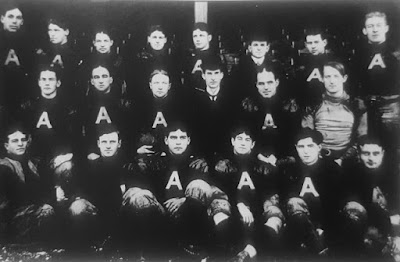When the Phillies and Athletics Played Football
In the business of baseball, Colonel
John Rogers and Benjamin Shibe were not allies.
To the contrary, Shibe was the largest owner of the Philadelphia
Athletics who played in the upstart American League. The A’s had signed away one of the stars of
Rogers’ Philadelphia Phillies, Nap Lajoie, in the premier season of 1901. Many of Lajoie’s teammates also jumped
leagues, which prompted Rogers to seek an injunction preventing former Phillies
from playing in American League games in the state of Pennsylvania.
But on the gridiron, Rogers and
Shibe became unlikely compatriots. In 1902,
football was becoming more popular in the United States. Rogers and Shibe saw an opportunity to benefit
from the rising popularity of the sport, and formed the first professional
football league: the National Football League.
The league, which is unrelated to the current NFL, had modest
beginnings. When it formed in 1902, it
had only three teams. Rogers called his
team the Philadelphia Phillies, and hired his baseball manager, Bill
Shettsline, to be the coach. Shibe
likewise called his team the Philadelphia Athletics. He named Charles “Blondy” Wallace as the A’s
coach, but hired Connie Mack as the team’s general manager.The third team hailed from Pittsburgh. The Pittsburgh Stars was owned by Dave Berry, who became the president of the team.
Many of the players in the league were baseball players. Two were future Hall of Famers. Christy Mattewson, the legendary pitcher for the New York Giant, played fullback for Pittsburgh. The A’s sported its left handed phenomenon, Rube Waddell, as a lineman.
Waddell’s association with the A’s football team had more to do with Mack’s desire to keep an eye on him during the off-season than with Waddell’s football prowess. Waddell had earned the nickname “Rube” because he was eccentric. He often left the dugout during a game to follow fire trucks to a fire. By having him on the football team, Mack could keep Waddell in line.
But it soon became clear to Mack and Shibe that having their star pitcher on the football team was too much of a risk. In practice, Waddell had tackled the quarterback, breaking the man’s leg. Not wanting to risk losing Waddell to injury, the Athletics did not use him in actual games for the rest of the season.
The season was structured as a round robin, with each team playing each other twice. By the end of the season, each team had split its series with the other two, leaving no clear champion. Mack agreed to have the Athletics play the Stars in a championship game for a price of $2,000. When the day of the game came, very few people were in the stands. Mack initially refused to have his team play until he was paid the $2,000. William Corey, who headed Carnegie Steel, was present and gave Mack a check for $2,000 to entice him to play. The game ended in a scoreless tie. A second championship game between the A’s and the Stars was played, with the Stars emerging victorious. The A’s claimed that these games were just exhibition matches, and declared themselves the league’s champions. Berry, however, had his team crowned the official champions, citing points scored to points allowed ratio.
Economically, the league was not a success. The A’s, for example, ended the 1902 season with a $4,000 loss. The NFL folded after one season. Although the A’s attempted to continue as a professional football team, in 1903 it played only two games before disbanding.
References
Ray
Didinger and Robert S. Lyons, The Eagles Encyclopedia (Temple University
Press 2005).
Frank
Fitzpatrick, “Connie Mack’s Football Team Preceded the Eagles,”
(August 25, 2011).
National
Baseball Hall of Fame, “Rube Waddell."
National
Football League, “History: 1869-1910."
Robert
W. Peterson, Pigskin: The Early Years of Pro Football (Oxford University
Press 1997).
The
Professional Football Researchers Association, “Dave Berry and the Philadelphia Story: The Very First N.F.L.”



Comments
Post a Comment